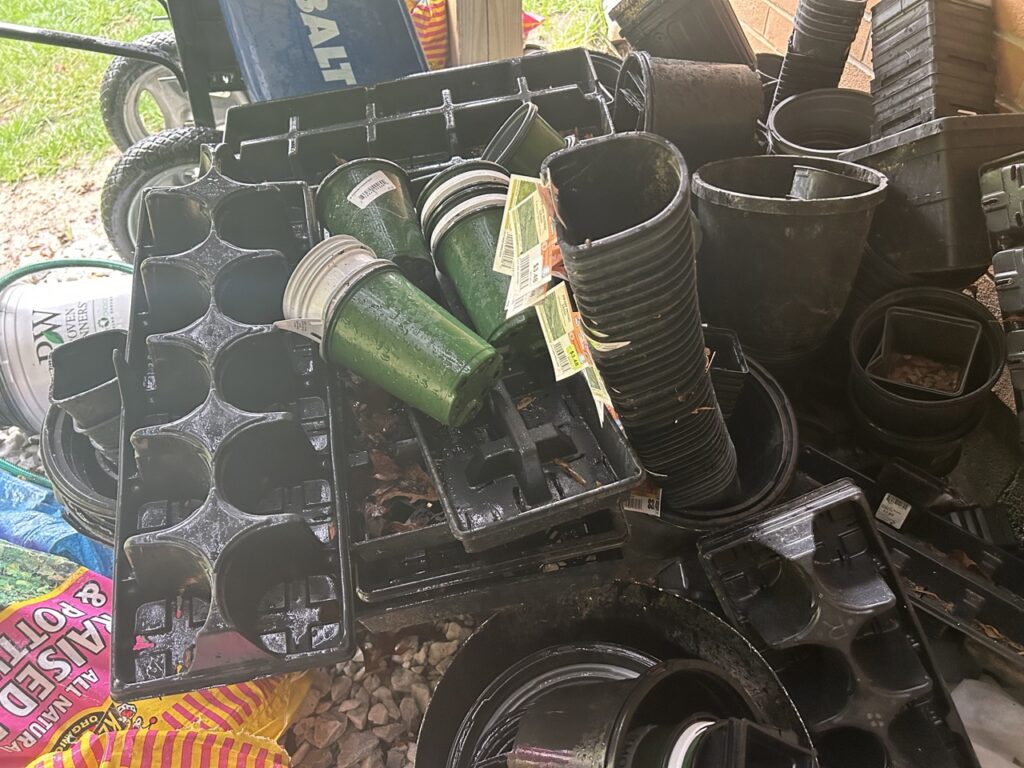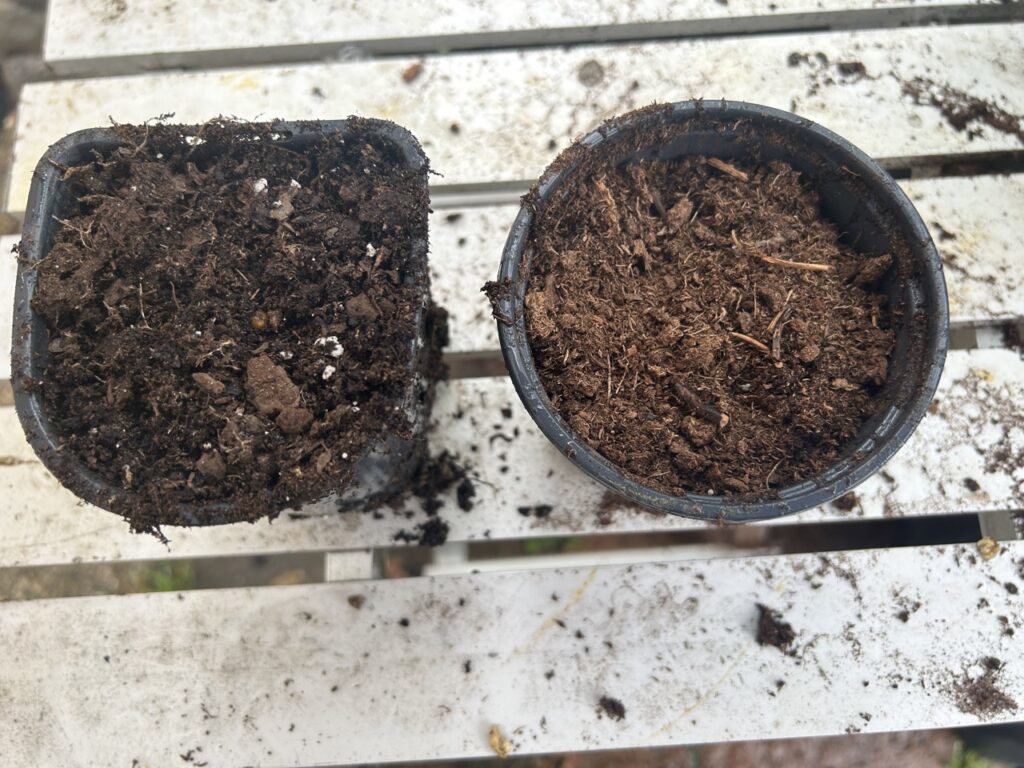Introduction: Meet the Grumpy Gnome and His Sidekick Shawn
Welcome to another tragic story coming directly from Bad Gnome Gardening, where our favorite gnome shares his gardening wisdom, mostly through making his sidekick, Shawn, do the hard stuff. Today, we’ll be diving into starting herbs indoors from seed. So, grab your favorite potting mix, roll up your sleeves, and let’s get going!
Recycled Plastic Pots: A Greener Choice
Bad Gnome: “You know what I hate, Shawn? Wasting money on expensive pots. Why not just use those recycled plastic pots from big box stores? They’re cheap, durable, and eco-friendly.”
Shawn: “Great question, Bad Gnome. Cheap, durable, and eco-friendly that’s exactly why we do it here at Bad Gnome Gardening. We’ve tried all types of starter pots including the biodegradable ones which take forever to decompose causing some of our transplants to become root bound. Plus, these containers are available in various sizes, so you can choose the perfect pot for your herbs. Reusing them means they won’t end up in a landfill somewhere.”

Shawn: “Plus the little containers fit perfectly in our indoor greenhouse when we start herbs indoors from seed. It’s really tragic the amount of plastic that ends up being thrown away. It is truly tragic.”
Peat Moss vs. Potting Soil: The Battle of the Growing Mediums
Bad Gnome: “And while you’re at it, fill those pots with peat moss instead of potting soil. It’s lighter, provides better aeration, and helps retain moisture. That’s a tip from someone with hundreds of years of experience speaking here. I was around before someone decided to go and create plastic. Have you seen what this has done to our oceans and beaches?”
Shawn: “I could not agree more with you on both points but let’s stay on topic here. It’s true that peat moss has some advantages, but remember it can be acidic, so it’s important to monitor the pH levels to ensure healthy plant growth. I prefer using the peat in paper egg cartons for starting tomatoes.”
Bad Gnome: “Man I love me some tomatoes. I wish I had one right now to sink my gnomish teeth into.”
Shawn: “Me, too. But I would like a nice Cherokee Purple, sliced, with a bit of course sea salt and fresh cracked pepper. However, I must continue the potting mix choices discussion.”
Bad Gnome: “Alrighty, then. Please proceed because I am getting a bit hungry with all of this tomato talk.”
Shawn: “Thanks, Bad Gnome. Let’s take a look at the differences with a visual.”

Bad Gnome: “Nice. I can really see a difference in composition from that image. Thanks. So the way I see it each can stand on its own but each excels in certain situations. For instance, it takes quite a bit of water to saturate peat whereas potting soil mixes are more forgiving in that regard. Conversely it seems to me that peat will tend to dry out more quickly. Makes sense to me because potting soil typically has exfoliated vermiculate which helps maintain moisture levels.”
Shawn: “Thanks for the education, Bad Gnome. Some of that you have told me before and the rest I was not aware of. I always learn something new when I’m around you.”
Bad Gnome: “This is why I am the brains of this operation and don’t you forget it, you, you young whippersnapper! Maybe we should move onto the next topic.”
Shawn: “Calm down, Bad Gnome. I was totally being honest when I said I learn a lot from you all the time. And yes, let us move on…”
Planting Parsley and Cilantro vs. Thyme or Basil: Different Herbs, Different Needs
Bad Gnome: “Now, let’s talk about planting some herbs. Parsley and cilantro are different from thyme and basil, so don’t treat them all the same. Each of their seeds are relatively the same size and each one typically will equate to one plant. Whereas, thyme and basil typically are smaller seeds and you can plant them more generously.”
Shawn: “Right. Also parsley and cilantro seeds need light to germinate, so don’t bury them too deeply. Thyme and basil, on the other hand, require a bit more depth in your right, you can be more generous with the seeds in the pots when you start them.”
Bad Gnome: “You’re starting to get it my lad! Finally my hard work seems to be paying off! It’s about time.”
Shawn: “Thanks, Bad Gnome. Now can we talk about light and temperature requirements?”
The Importance of Grow Lights and Temperature Control
Bad Gnome: “Nice segue. Speaking of light, make sure you’ve got good grow lights for these indoor herbs. And don’t forget to control the temperature to encourage germination. Much of the temperature you need will come from a grow light, however, be careful not to burn things up because in our indoor greenhouse, it can get up to 90° on the top shelf. You can always use a fan to cool it down whilst fanning your tomatoes. Did I mention that I happen to L-O-V-E tomatoes? Nearly as much as a tankard of fine Gnomish Ale. Heck I’d even be happy with a Long Island Gnome.”
Shawn: “Yep you’re right, Bad Gnome, different herbs have different temperature preferences. Most herbs germinate well at temperatures between 65-75°F (18-24°C), but always check the specific requirements for the herbs you’re growing.”
Bad Gnome: “That is really great advice. Thanks for sharing a small piece of your limited knowledge of gardening, my budding young pupil.”
Shawn: “Right… Well, let’s move on. Now I need a drink.”
Misting, Plastic Wrap, and Rain Exposure
Bad Gnome: “Next topic. How do we keep these seeds moist so they will germinate? Do you know? Do you know? Do you? Here, let me help. You keep the seeds moist by misting them with filtered water twice a day. And use plastic wrap to control moisture, but remove it once the seedlings emerge.”
Shawn: “Spot on Bad Gnome. And you’re absolutely correct. Also keep in mind as the plants grow, it’s a good idea to place them outside in the rain periodically. This helps them adapt to outdoor conditions before transplanting. Do be mindful of the temperatures because low temps can shock the tender young plants.”
Bad Gnome: “You are starting to sound more and more like me every day! Maybe I am rubbing off on you after all.”
The Parsley Problem: An Unexpected Surprise
Bad Gnome: “You know, Shawn, we’ve had our share of struggles here at Bad Gnome Gardening. Remember when our parsley seeds didn’t germinate and we used the pots for peppers instead?”
Shawn: “Oh, yes. And now we have parsley seedlings coming up everywhere, alongside the peppers!”

Herbs Growing with Peppers
Bad Gnome: “We’ll just let them grow and eventually we can transplant them. It never hurts to have a few herbs around, especially around nightshades as keeps the pests away like those pesky squirrels. I hate squirrels. I’m sure I’ve mentioned that before. Squirrels! Squirrels! Squirrels! Squirrels! Squirrels!
Conclusion: Embrace Bad Gnome’s Indoor Gardening Wisdom
Starting herbs indoors from seed might seem like a daunting task, especially when you’ve got a old grumpy gnome making you do all the hard work. But with the tips and tricks shared by Bad Gnome and his side-kick Shawn, you’ll be well on your way to enjoying a bountiful indoor herb garden.
Remember to use recycled plastic pots, consider peat moss as a growing medium, and pay attention to the specific needs of your chosen herbs. Keep a close eye on light, temperature, and moisture, and don’t be discouraged if some seeds don’t germinate as expected – they might just surprise you later.

Now, go forth and put your newfound knowledge to good use, turning your indoor space into a thriving herb garden. With a little patience, dedication, and the guidance of our benevolent dictator/grumpy gnome and his trusty sidekick, you’ll soon be reaping the rewards of your hard work.
Happy planting!
Cheers,
Bad Gnome and Shawn

[…] Shawn: “Indeed it does add a splash of color, Bad Gnome. The reddish-purple appearance of the leaves is caused by a high content of dark blue pigments, i.e. anthocyanins, in the plant cells. Tip: The pigments in the leaves develop more intensely when the plants are in a sunny location. Don’t forget the other herbs – large Italian parsley, cilantro, and thyme. Each has its own unique flavor and benefits. We have an entire post dedicated to actually starting these herbs indoors.” […]